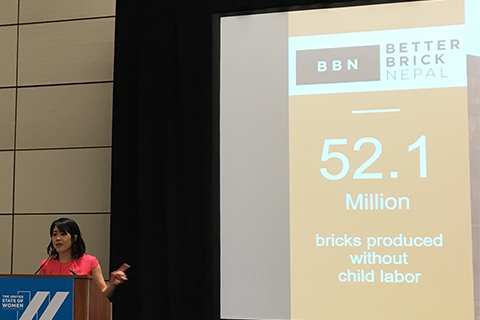
On Tuesday, the White House held the first ever United State of Women Summit, bringing together thousands of women and men to celebrate the achievements made on behalf of women over the last decade, and to highlight the issues that continue to face women, girls, and their communities at home and around the world.
We were invited to participate in a solution seminar, “Away from Slavery and Towards Human Rights: Ending Trafficking of Women and Girls” moderated by Ambassador-At-Large Susan Coppedge to highlight some of the unconventional solutions Humanity United has been part of developing.
———
Over the past fifteen years, the anti-human trafficking community has learned much about how trafficking works and what conditions make modern slavery possible. To make a lasting impact on this issue though, we must change whole systems of exploitation and abuse.
To do that, we need business leaders, media leaders, civic leaders, consumers, and citizens to bring their energy and talents to this fight. We need educated consumers pushing for responsible business behavior; we need engaged citizens holding governments to account; and we need civic leaders, demanding better outcomes for trafficking survivors in our midst.
Humanity United is at the forefront of this approach, seeking better incentives, new partnerships and unconventional voices. Below are three partnerships: Better Bricks Nepal (BBN), the Partnership for Freedom, and the Guardian serving as quantifiable examples of how unlikely partnerships can lead to better solutions.
By the numbers:
52.1 million…
is the number of bricks now being produced in Nepal without child labor because of the Better Brick Nepal consortium.
Even before last year’s devastating earthquake, Nepal’s brick industry included 30,000 – 60,000 children producing bricks to build hotels, airports, hospitals, schools, office buildings, temples and homes across the country. Child labor and bonded labor are widespread in Nepal, and efforts to educate employers about child labor have had mixed success.
Understanding what worked and didn’t work in the past, BBN created an innovative approach that incentives brick kiln owners to improve the efficiency and productivity of their factories, and simultaneously disincentivizes them from employing children. The program works directly with buyers to purchase ethically produced bricks, with kiln owners to shift their market incentives, and with families to keep kids in school and change attitudes about having them work.
The international donor community has pledged four billion dollars to help Nepal rebuild. Now international donors and local consumers in Nepal can choose — a brick that was likely made with child labor, or a brick we know was made by an adult.
3 minutes…
Is the length of time it now takes a case manager using the Safe Night platform to find emergency shelter for a trafficking survivor. Before the Safe Shelter Collaborative developed this online platform to identify vacant shelter beds, it could take up to a week for a trafficking survivor to find safe shelter. How did this idea come about?
The Safe Shelter Collaborative is a partnership between technology company Caravan Studios, and Polaris. Together, they were the first winners of the Partnership for Freedom challenge, a multimillion dollar public-private partnership between Humanity United, five federal agencies, and three other foundations. The goal of the Partnership for Freedom is to spur innovation in combating human trafficking, where private philanthropic dollars take on the risk of new ideas, and public funds evaluate and eventually scale the ideas that work. When we created this partnership, we knew we needed to spur new ideas, new action, new commitment and new data to this fight, and the Safe Shelter Collaborative is a fantastic example of this vision.
More than 10 million…
Is the number of consumers who now know that human trafficking exists in their seafood because of the Guardian’s reporting. Over the last two years, the Guardian’s investigative journalists have linked enslaved Thai, Burmese, Cambodian and Indonesian workers to fish sold in the US, UK and elsewhere in Europe.
In 2013 HU and the Guardian began a partnership called Modern Day Slavery in Focus to bring more nuanced and deeper reporting to human trafficking and to tell the stories about root causes of trafficking, instead of focusing on rescues, raids and law enforcement operations. The Guardian maintains complete editorial independence from HU.
Two million readers saw the original Guardian reporting, but other major leading news outlets like the AP, Reuters and the New York Times followed up with stories of their own, leading to tens of millions of people reading about the plight of seafood workers. These reports together with the work of a committed network of NGOs have resulted in incredible corporate, consumer and governmental pressure, including from the U.S. State Department, the European Union, and major supermarket chains to force Thailand’s $7 billion-dollar fishing industry to change.